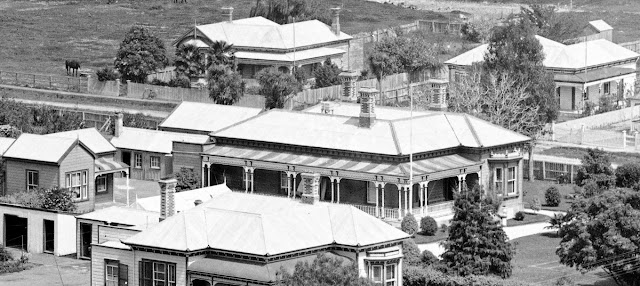Introduction
Beach Road, at the Grahamstown end of Thames - a quiet spot, with a narrow road, that has metal parking areas.
The south side of Victoria Park is on the western side, along with the Petanque area and Croquet Club. Travel further north and there is an access to the walkway that loops around the coast to the old Burke Street Wharf. On the eastern side you start at Albert Street, to Williamson Street, past A & G Price Foundry to the Burke Street intersect - then the road becomes Tararu Road.
Then & Now: 1900s & 2018 Corner of Beach Road and Albert Street.
Beach Road History (From Streets of Thames) "Named after the location, originally adjacent to the beach before reclamation was carried out.
On the 1868 map there is no Beach Road, although there is an unnamed road (where Brown street meets Cochrane Street and along to Pahau Street).
The 1910s Cleave’s map records Beach Road extending to Mary Street as well as a portion of road from Albert Street to Coromandel Street intersect. The road length was changed in 1938, today Beach Road only runs from Burke Street (north) to Albert Street (south)."
1868 map - Beach Road does not exist. The red line marks the location of Beach Road today.
Residents and business along the foreshore gave their address as The Beach.
1910s Map - the 'x's mark the two portions of Beach Road. Coromandel intersect to Albert Street intersect; and Cochrane to Mary Street intersects.
Collage View of Victoria Park south, on Beach Road.
In the 1900s, the view was unobstructed,
and you could watch the ships arriving at the Burke Street Wharf.
Residents of Beach Road 1870 and 1923
In the Thames Directory 1870, the road still does not formally exist, however a large group of businesses and residents record their address as "Beach". They included: Joseph Bargrove's Ladies' School, H C Lawlor, Joseph Faltt (carpenter), John McConnell, Charles Toft (store dealer), James Buchanan (stone-cutter), John Taylor (Bay View Timber Yard), William Anderson (architect), John Gwynneth, R N Smith (store dealer), M Rae ( Cornwallis Saw Mills, Miss Shepherd (actress), Richard Dodd's Boarding-house, Henry Phillips (boat builder), Holdship's Timber Yard, Wesleyan Chapel, Thomas Sharp (engineer), S Smale (legal manager), Thomas Keven's Boarding-house, John McColloch, Frederick Smith, Richard Richards, Marine Fmaily Hotel, Native Office (E Puckey), C F Quint, M Browne (coal merchant), Alexander Unthank (coal merchant), B Jones (actor) and George McAnnalley (telegraph linesman).
In the Cleave's Street Directory 1923 the names recorded in Beach Road are:
Right side from Haven Street: Thames Railway Station, John Arthur (stationmaster) ... nothing further is recorded until Mary Streets.
On the left hand side from Haven Street: A & G Price Bulk Store, William Wells (labourer), Charles Fleming (moulder), John Coutts (boilermaker), Arthur Henderson (fitter).
Burke Street intersect. A & G Price Ltd. Abraham Street intersect. Rawiri Pearson (carpenter), Wm H Lucas (JP), Mrs Dunbar (Gwendon Boardinghouse), Thomas Dunbar (hairdresser - private residence), John Milner (boilermaker), Thomas McLeay (tailor),
John Galloway (grocer).
Williamson Street intersect. John Salmon (SM), Reg Williams (Manager A & G Price), James Parkinson (jeweller), Alf Lomas (carter), Park Hotel (back entrance).
Albert Street intersects. Cochrane Street intersects.
Richard Dovell (carrier), Wm Milne (foundry hand), Jas Frogley (store manager), Mrs Margaret Bayldon, Arthur Batchelor (machinist), John Judd (pattern maker).
Amy Street intersects. Mrs Elizabeth Heard, Miss Alice Wishart, John Wells (labourer), William Skelley (labourer), Duncan McKenzie (bush contractor).
Walters Street intersects. Mary Streets intersect.
Closing Comments
Once a thriving street, Beach Road was full of businesses and residents. A popular place to live for those who worked at the foundry as evident in the Cleaves 1923 Street Directory. A busy and noisy place, close to A & G Price, and an area that once boasted a railway track, in the days of the trains being made and refurbished at the nearby foundry.
Take the Challenge
Wander the streets - stop and imagine how it would have looked one hundred years ago.
CLICK HERE for further Street 'Then & Now" photos.



















































